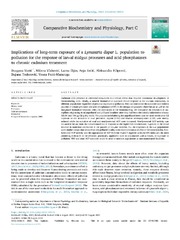Приказ основних података о документу
Implications of long-term exposure of a Lymantria dispar L. population to pollution for the response of larval midgut proteases and acid phosphatases to chronic cadmium treatment.
| dc.creator | Matić, Dragana | |
| dc.creator | Vlahović, Milena | |
| dc.creator | Ilijin, Larisa | |
| dc.creator | Grčić, Anja | |
| dc.creator | Filipović, Aleksandra | |
| dc.creator | Todorović, Dajana | |
| dc.creator | Perić Mataruga, Vesna | |
| dc.date.accessioned | 2021-10-14T11:13:18Z | |
| dc.date.available | 2021-10-14T11:13:18Z | |
| dc.date.issued | 2021 | |
| dc.identifier.issn | 1532-0456 | |
| dc.identifier.uri | https://linkinghub.elsevier.com/retrieve/pii/S153204562100199X | |
| dc.identifier.uri | https://radar.ibiss.bg.ac.rs/handle/123456789/4480 | |
| dc.description.abstract | Cadmium (Cd) presence in terrestrial ecosystems is a serious threat that requires continuous development of biomonitoring tools. Ideally, a suitable biomarker of exposure should respond to the toxicant consistently in different populations regardless of previous exposure to pollution. Here we considered the activities and isoform patterns of certain proteases and acid phosphatases (ACP) in the midgut of Lymantria dispar larvae as well as the integrated biomarker response (IBR) for application in Cd biomonitoring. We compared the responses of caterpillars originating from unpolluted and polluted localities after they had been chronically subjected to dietary Cd (50 and 100 μg Cd/g dry food). The population inhabiting the unpolluted forest was far more sensitive to Cd exposure as the activities of total proteases, trypsin (TRY) and leucine aminopeptidase (LAP) were mostly reduced while the activities of total and non-lysosomal ACP were increased. Non-lysosomal ACP activity was elevated in larvae from the contaminated site in response to the higher Cd concentration. Exposure to the metal resulted in numerous alterations in the pattern of enzyme isoforms, but the responses of the two populations were similar except that larvae from the polluted locality were more tolerant to the lower Cd concentration. Non-lysosomal ACP activity and the appearance of ACP isoforms 4 and 5 together with the IBR index are the most promising indicators of Cd presence, potentially applicable even in populations with a history of exposure to pollution. TRY and total ACP activities could be used to monitor populations at uncontaminated localities. | |
| dc.publisher | Elsevier Inc. | |
| dc.relation | info:eu-repo/grantAgreement/MESTD/inst-2020/200007/RS// | |
| dc.rights | openAccess | |
| dc.rights.uri | https://creativecommons.org/licenses/by-nc-nd/4.0/ | |
| dc.source | Comparative Biochemistry and Physiology Part C: Toxicology & Pharmacology | |
| dc.subject | Acid phosphatases | |
| dc.subject | Biomarker | |
| dc.subject | Heavy metal | |
| dc.subject | Integrated biomarker response (IBR) | |
| dc.subject | Proteases | |
| dc.title | Implications of long-term exposure of a Lymantria dispar L. population to pollution for the response of larval midgut proteases and acid phosphatases to chronic cadmium treatment. | |
| dc.type | article | en |
| dc.rights.license | BY-NC-ND | |
| dcterms.abstract | Тодоровић, Дајана; Илијин, Лариса; Грчић, Aња; Филиповић, Aлександра; Влаховић, Милена; Перић-Матаруга, Весна; Матић, Драгана; | |
| dc.rights.holder | © 2021 The Authors. Published by Elsevier Inc. | |
| dc.citation.volume | 250 | |
| dc.identifier.doi | 10.1016/j.cbpc.2021.109172 | |
| dc.identifier.pmid | 34461292 | |
| dc.identifier.scopus | 2-s2.0-85114164293 | |
| dc.identifier.wos | 000703789700001 | |
| dc.citation.apa | Matić, D., Vlahović, M., Ilijin, L., Grčić, A., Filipović, A., Todorović, D., et al. (2021). Implications of long-term exposure of a Lymantria dispar L. population to pollution for the response of larval midgut proteases and acid phosphatases to chronic cadmium treatment. Comparative Biochemistry and Physiology Part C: Toxicology & Pharmacology, 250, 109172. | |
| dc.citation.vancouver | Matić D, Vlahović M, Ilijin L, Grčić A, Filipović A, Todorović D, Perić-Mataruga V. Implications of long-term exposure of a Lymantria dispar L. population to pollution for the response of larval midgut proteases and acid phosphatases to chronic cadmium treatment. Comp Biochem Physiol Part C Toxicol Pharmacol. 2021;250:109172. | |
| dc.citation.spage | 109172 | |
| dc.type.version | publishedVersion | |
| dc.identifier.fulltext | https://radar.ibiss.bg.ac.rs/bitstream/id/9292/1-s2.0-S153204562100199X-main.pdf | |
| dc.citation.rank | aM21 |

